Business Model and Business Development: Strategies and Implications
VerifiedAdded on 2020/03/07
|9
|2436
|78
Essay
AI Summary
This essay comprehensively examines the pivotal role of business models in shaping business strategies and driving development. It delves into the core components of a business model, including its function in creating, delivering, and capturing value within a specific economic and social context. The essay explores different business model archetypes, the activity systems, and revenue architectures, emphasizing the importance of Total Productive Maintenance (TPM) in ensuring smooth workflows. It further discusses the impact of static and dynamic business components and the challenges that can arise from the business model design. The analysis highlights the significance of the business context, particularly the influence of big data, and how companies like Capgemini are adapting their business models to leverage technological advancements and skilled personnel. The essay concludes by emphasizing the business model's role in determining revenue growth and profitability, while also addressing the need for clear business objectives and the ability to navigate the ever-changing business landscape.

Running head: BUSINESS MODEL AND BUSINESS DEVELOPMENT
BUSINESS MODEL AND BUSINESS DEVELOPMENT
Name of the University
Name of the Student
Author Note
BUSINESS MODEL AND BUSINESS DEVELOPMENT
Name of the University
Name of the Student
Author Note
Paraphrase This Document
Need a fresh take? Get an instant paraphrase of this document with our AI Paraphraser

1BUSINESS MODEL AND BUSINESS DEVELOPMENT
The business model of any organization denotes a precise and clear picture of the
operational business of the organization. Precisely the business model is something that
includes the principles of the business regarding the creation, delivery and the capture of the
business values in the context of the culture, economy and the society. Business model is
considered as the part of the business strategies of the business organization. It is meant that
the business model of any firm is the way of interpretation of the value proposition to the
existing for profitability and the revenue growth. In other way, business model is the means
of generating the rapid growth of the revenue for the organization (Schaltegger, Lüdeke-
Freund & Hansen, 2012).
The business model intents the purpose and the function of the business. For
completing rightly the function of the business, the business model requires a background and
context. The most popular business models are based on the several business personalities or
the fundamental template that are called the business model archetype (Bocken et al., 2014).
A business archetype is necessary to understand the business model of any organization.
Primarily there are seven business model archetypes for understanding the categories of the
business, which are further divided into two sections, primary and the secondary. The
business archetype suggests and makes way for the management of the business to plan their
strategies according to the structural spectrum options.
The overall and the basic purpose and objective of a business model is to focusing on
the creation of the business growth of the business, which is reflected in the value proposition
of the customers. The involvement of the physical human recourses and the capital resources
of the business model for the fulfillment of the business goals is considered to the activity of
the business. The activity system of the business model entails the set of organizational
activities that are internally dependent centering on the organization (Bocken, N. M. P.,
Short, S. W., Rana, P., & Evans, S. (2014. The activity system executes the activities of the
The business model of any organization denotes a precise and clear picture of the
operational business of the organization. Precisely the business model is something that
includes the principles of the business regarding the creation, delivery and the capture of the
business values in the context of the culture, economy and the society. Business model is
considered as the part of the business strategies of the business organization. It is meant that
the business model of any firm is the way of interpretation of the value proposition to the
existing for profitability and the revenue growth. In other way, business model is the means
of generating the rapid growth of the revenue for the organization (Schaltegger, Lüdeke-
Freund & Hansen, 2012).
The business model intents the purpose and the function of the business. For
completing rightly the function of the business, the business model requires a background and
context. The most popular business models are based on the several business personalities or
the fundamental template that are called the business model archetype (Bocken et al., 2014).
A business archetype is necessary to understand the business model of any organization.
Primarily there are seven business model archetypes for understanding the categories of the
business, which are further divided into two sections, primary and the secondary. The
business archetype suggests and makes way for the management of the business to plan their
strategies according to the structural spectrum options.
The overall and the basic purpose and objective of a business model is to focusing on
the creation of the business growth of the business, which is reflected in the value proposition
of the customers. The involvement of the physical human recourses and the capital resources
of the business model for the fulfillment of the business goals is considered to the activity of
the business. The activity system of the business model entails the set of organizational
activities that are internally dependent centering on the organization (Bocken, N. M. P.,
Short, S. W., Rana, P., & Evans, S. (2014. The activity system executes the activities of the
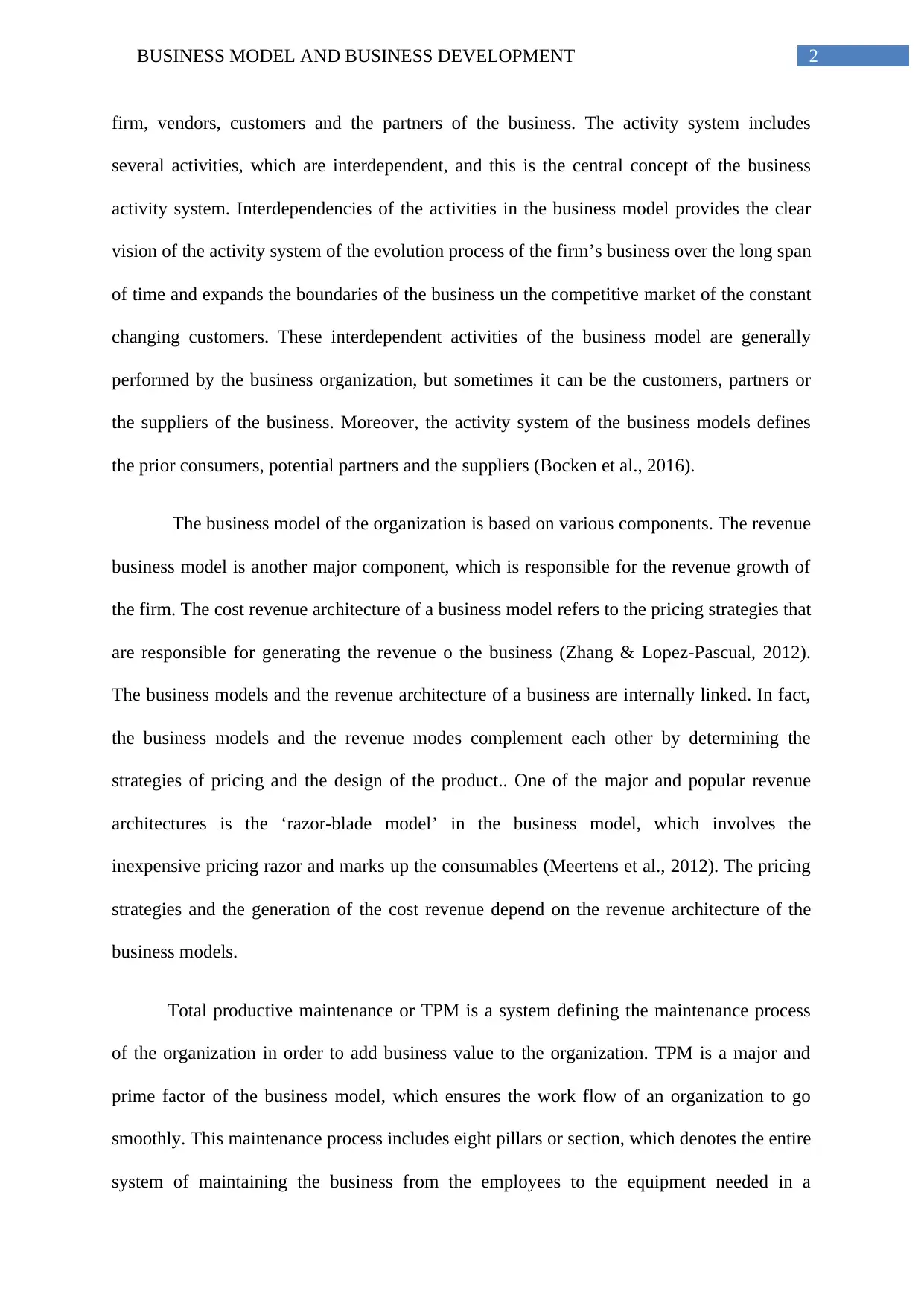
2BUSINESS MODEL AND BUSINESS DEVELOPMENT
firm, vendors, customers and the partners of the business. The activity system includes
several activities, which are interdependent, and this is the central concept of the business
activity system. Interdependencies of the activities in the business model provides the clear
vision of the activity system of the evolution process of the firm’s business over the long span
of time and expands the boundaries of the business un the competitive market of the constant
changing customers. These interdependent activities of the business model are generally
performed by the business organization, but sometimes it can be the customers, partners or
the suppliers of the business. Moreover, the activity system of the business models defines
the prior consumers, potential partners and the suppliers (Bocken et al., 2016).
The business model of the organization is based on various components. The revenue
business model is another major component, which is responsible for the revenue growth of
the firm. The cost revenue architecture of a business model refers to the pricing strategies that
are responsible for generating the revenue o the business (Zhang & Lopez-Pascual, 2012).
The business models and the revenue architecture of a business are internally linked. In fact,
the business models and the revenue modes complement each other by determining the
strategies of pricing and the design of the product.. One of the major and popular revenue
architectures is the ‘razor-blade model’ in the business model, which involves the
inexpensive pricing razor and marks up the consumables (Meertens et al., 2012). The pricing
strategies and the generation of the cost revenue depend on the revenue architecture of the
business models.
Total productive maintenance or TPM is a system defining the maintenance process
of the organization in order to add business value to the organization. TPM is a major and
prime factor of the business model, which ensures the work flow of an organization to go
smoothly. This maintenance process includes eight pillars or section, which denotes the entire
system of maintaining the business from the employees to the equipment needed in a
firm, vendors, customers and the partners of the business. The activity system includes
several activities, which are interdependent, and this is the central concept of the business
activity system. Interdependencies of the activities in the business model provides the clear
vision of the activity system of the evolution process of the firm’s business over the long span
of time and expands the boundaries of the business un the competitive market of the constant
changing customers. These interdependent activities of the business model are generally
performed by the business organization, but sometimes it can be the customers, partners or
the suppliers of the business. Moreover, the activity system of the business models defines
the prior consumers, potential partners and the suppliers (Bocken et al., 2016).
The business model of the organization is based on various components. The revenue
business model is another major component, which is responsible for the revenue growth of
the firm. The cost revenue architecture of a business model refers to the pricing strategies that
are responsible for generating the revenue o the business (Zhang & Lopez-Pascual, 2012).
The business models and the revenue architecture of a business are internally linked. In fact,
the business models and the revenue modes complement each other by determining the
strategies of pricing and the design of the product.. One of the major and popular revenue
architectures is the ‘razor-blade model’ in the business model, which involves the
inexpensive pricing razor and marks up the consumables (Meertens et al., 2012). The pricing
strategies and the generation of the cost revenue depend on the revenue architecture of the
business models.
Total productive maintenance or TPM is a system defining the maintenance process
of the organization in order to add business value to the organization. TPM is a major and
prime factor of the business model, which ensures the work flow of an organization to go
smoothly. This maintenance process includes eight pillars or section, which denotes the entire
system of maintaining the business from the employees to the equipment needed in a
⊘ This is a preview!⊘
Do you want full access?
Subscribe today to unlock all pages.

Trusted by 1+ million students worldwide

3BUSINESS MODEL AND BUSINESS DEVELOPMENT
business. The purpose of TPM in a business model is to provide and ensure proper
improvement of the organization through every level (Rajput & Jayaswal, 2012). Be it the
elimination of the employee conflict within the organization, or the quality issues regarding
the product, TPM manages the all. It is considered that TPM is one of the vital part of an
organization in designing their business model and securing the efficiency in productivity.
The business model of a firm is capable of resolving the dynamic and the static
business problems that often arise in the business process (Chen & Patton, 2012). The
business model helps the organization’s operational activity to be executed by solving the
static problems of the business. The static attributes of the business support the organization
to accomplish the present business activities without obligations. However, the static
components of the business do not always seem to be helpful for the organization, since it
prevents the innovative growth of the organization. Thus, the business model of the
organization requires incorporating the dynamic components of the business for integrating
the innovative features in the same. The dynamic properties of the business model help the
organization to accommodate and respond appositely to the contemporary market
environment. The design of the business model proposes the conceptualization of the
business objectives to carry out the constant and the elastic properties of the business model
for overall profit and growth of the revenue in the global market (Weske, 2012).
The business model of an organization, being the prime determinate of the business
strategies is capable of creating problems and conflicts. The entrepreneur of any organization
approaches the innovations in the business model, which the potential business personnel are
not familiar with (Massa & Tucci, 2013). Another problem arises with the fact that questions
the similarity of the business model with the business strategies. The overlap of the business
strategies with the intellectual territory creates another problem in the business model. For
example, dealing the two different and competing business models in the same industry needs
business. The purpose of TPM in a business model is to provide and ensure proper
improvement of the organization through every level (Rajput & Jayaswal, 2012). Be it the
elimination of the employee conflict within the organization, or the quality issues regarding
the product, TPM manages the all. It is considered that TPM is one of the vital part of an
organization in designing their business model and securing the efficiency in productivity.
The business model of a firm is capable of resolving the dynamic and the static
business problems that often arise in the business process (Chen & Patton, 2012). The
business model helps the organization’s operational activity to be executed by solving the
static problems of the business. The static attributes of the business support the organization
to accomplish the present business activities without obligations. However, the static
components of the business do not always seem to be helpful for the organization, since it
prevents the innovative growth of the organization. Thus, the business model of the
organization requires incorporating the dynamic components of the business for integrating
the innovative features in the same. The dynamic properties of the business model help the
organization to accommodate and respond appositely to the contemporary market
environment. The design of the business model proposes the conceptualization of the
business objectives to carry out the constant and the elastic properties of the business model
for overall profit and growth of the revenue in the global market (Weske, 2012).
The business model of an organization, being the prime determinate of the business
strategies is capable of creating problems and conflicts. The entrepreneur of any organization
approaches the innovations in the business model, which the potential business personnel are
not familiar with (Massa & Tucci, 2013). Another problem arises with the fact that questions
the similarity of the business model with the business strategies. The overlap of the business
strategies with the intellectual territory creates another problem in the business model. For
example, dealing the two different and competing business models in the same industry needs
Paraphrase This Document
Need a fresh take? Get an instant paraphrase of this document with our AI Paraphraser
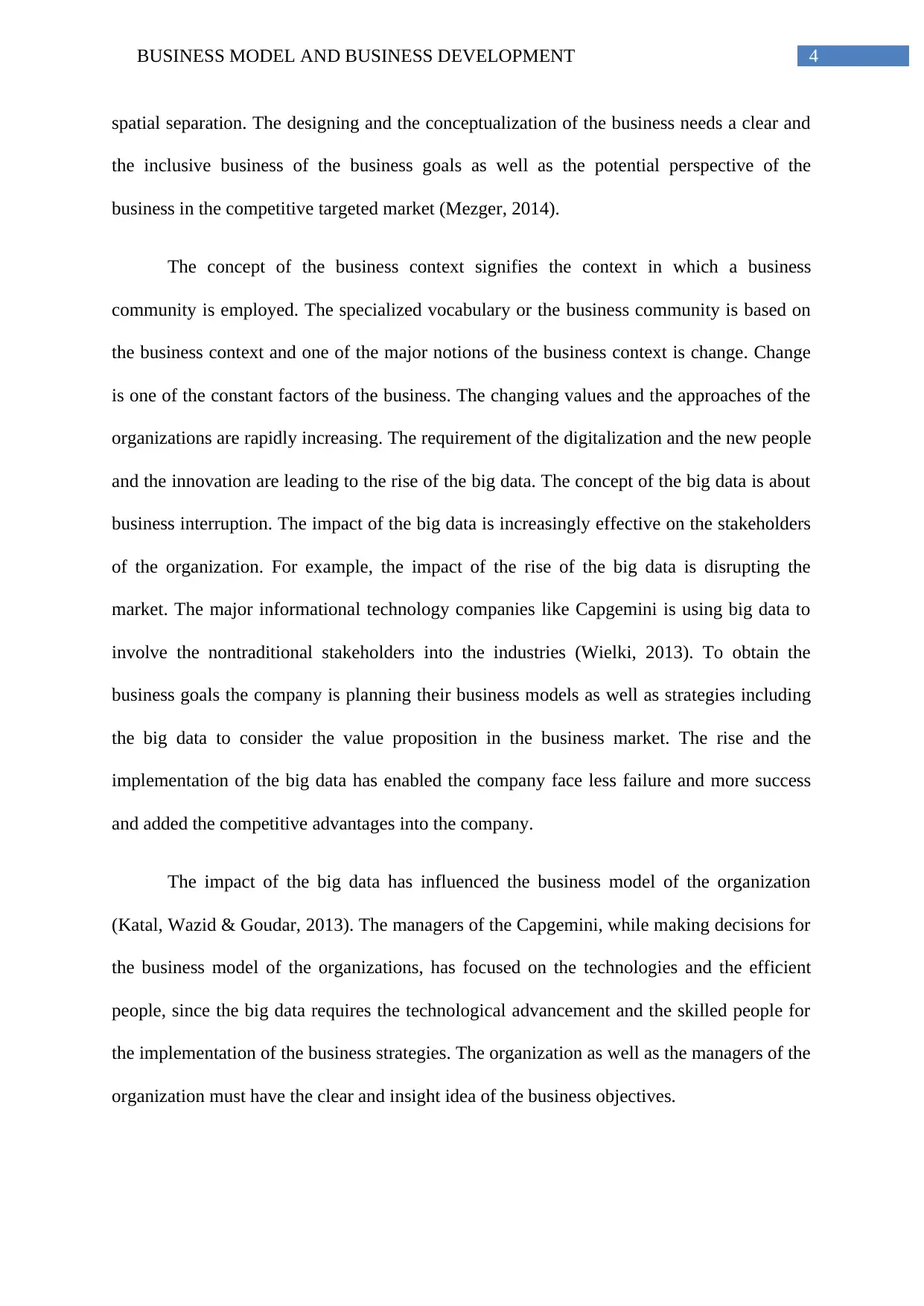
4BUSINESS MODEL AND BUSINESS DEVELOPMENT
spatial separation. The designing and the conceptualization of the business needs a clear and
the inclusive business of the business goals as well as the potential perspective of the
business in the competitive targeted market (Mezger, 2014).
The concept of the business context signifies the context in which a business
community is employed. The specialized vocabulary or the business community is based on
the business context and one of the major notions of the business context is change. Change
is one of the constant factors of the business. The changing values and the approaches of the
organizations are rapidly increasing. The requirement of the digitalization and the new people
and the innovation are leading to the rise of the big data. The concept of the big data is about
business interruption. The impact of the big data is increasingly effective on the stakeholders
of the organization. For example, the impact of the rise of the big data is disrupting the
market. The major informational technology companies like Capgemini is using big data to
involve the nontraditional stakeholders into the industries (Wielki, 2013). To obtain the
business goals the company is planning their business models as well as strategies including
the big data to consider the value proposition in the business market. The rise and the
implementation of the big data has enabled the company face less failure and more success
and added the competitive advantages into the company.
The impact of the big data has influenced the business model of the organization
(Katal, Wazid & Goudar, 2013). The managers of the Capgemini, while making decisions for
the business model of the organizations, has focused on the technologies and the efficient
people, since the big data requires the technological advancement and the skilled people for
the implementation of the business strategies. The organization as well as the managers of the
organization must have the clear and insight idea of the business objectives.
spatial separation. The designing and the conceptualization of the business needs a clear and
the inclusive business of the business goals as well as the potential perspective of the
business in the competitive targeted market (Mezger, 2014).
The concept of the business context signifies the context in which a business
community is employed. The specialized vocabulary or the business community is based on
the business context and one of the major notions of the business context is change. Change
is one of the constant factors of the business. The changing values and the approaches of the
organizations are rapidly increasing. The requirement of the digitalization and the new people
and the innovation are leading to the rise of the big data. The concept of the big data is about
business interruption. The impact of the big data is increasingly effective on the stakeholders
of the organization. For example, the impact of the rise of the big data is disrupting the
market. The major informational technology companies like Capgemini is using big data to
involve the nontraditional stakeholders into the industries (Wielki, 2013). To obtain the
business goals the company is planning their business models as well as strategies including
the big data to consider the value proposition in the business market. The rise and the
implementation of the big data has enabled the company face less failure and more success
and added the competitive advantages into the company.
The impact of the big data has influenced the business model of the organization
(Katal, Wazid & Goudar, 2013). The managers of the Capgemini, while making decisions for
the business model of the organizations, has focused on the technologies and the efficient
people, since the big data requires the technological advancement and the skilled people for
the implementation of the business strategies. The organization as well as the managers of the
organization must have the clear and insight idea of the business objectives.
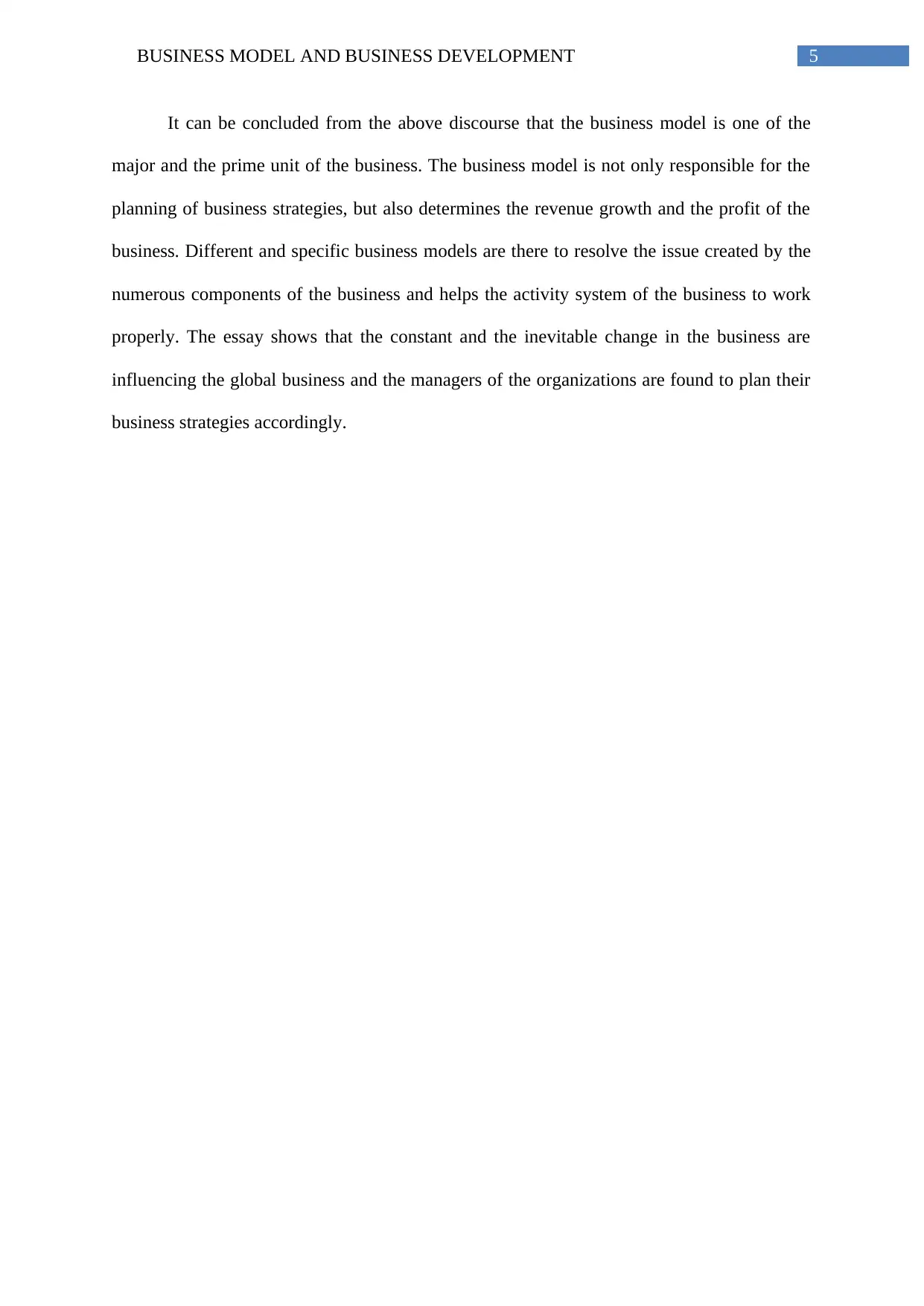
5BUSINESS MODEL AND BUSINESS DEVELOPMENT
It can be concluded from the above discourse that the business model is one of the
major and the prime unit of the business. The business model is not only responsible for the
planning of business strategies, but also determines the revenue growth and the profit of the
business. Different and specific business models are there to resolve the issue created by the
numerous components of the business and helps the activity system of the business to work
properly. The essay shows that the constant and the inevitable change in the business are
influencing the global business and the managers of the organizations are found to plan their
business strategies accordingly.
It can be concluded from the above discourse that the business model is one of the
major and the prime unit of the business. The business model is not only responsible for the
planning of business strategies, but also determines the revenue growth and the profit of the
business. Different and specific business models are there to resolve the issue created by the
numerous components of the business and helps the activity system of the business to work
properly. The essay shows that the constant and the inevitable change in the business are
influencing the global business and the managers of the organizations are found to plan their
business strategies accordingly.
⊘ This is a preview!⊘
Do you want full access?
Subscribe today to unlock all pages.

Trusted by 1+ million students worldwide

6BUSINESS MODEL AND BUSINESS DEVELOPMENT
Reference:
Bocken, N. M. P., Short, S. W., Rana, P., & Evans, S. (2014). A literature and practice review
to develop sustainable business model archetypes. Journal of cleaner production, 65,
42-56.
Bocken, N. M., de Pauw, I., Bakker, C., & van der Grinten, B. (2016). Product design and
business model strategies for a circular economy. Journal of Industrial and
Production Engineering, 33(5), 308-320.
Casadesus‐Masanell, R., & Zhu, F. (2013). Business model innovation and competitive
imitation: The case of sponsor‐based business models. Strategic management
journal, 34(4), 464-482.
Chen, J., & Patton, R. J. (2012). Robust model-based fault diagnosis for dynamic
systems (Vol. 3). Springer Science & Business Media.
Katal, A., Wazid, M., & Goudar, R. H. (2013, August). Big data: issues, challenges, tools and
good practices. In Contemporary Computing (IC3), 2013 Sixth International
Conference on (pp. 404-409). IEEE.
Massa, L., & Tucci, C. L. (2013). Business model innovation. The Oxford handbook of
innovation management, 20, 18.
Meertens, L. O., Iacob, M. E., Nieuwenhuis, L. J., Van Sinderen, M. J., Jonkers, H., &
Quartel, D. (2012, March). Mapping the business model Canvas to ArchiMate.
In Proceedings of the 27th annual ACM symposium on applied computing (pp. 1694-
1701). ACM.
Reference:
Bocken, N. M. P., Short, S. W., Rana, P., & Evans, S. (2014). A literature and practice review
to develop sustainable business model archetypes. Journal of cleaner production, 65,
42-56.
Bocken, N. M., de Pauw, I., Bakker, C., & van der Grinten, B. (2016). Product design and
business model strategies for a circular economy. Journal of Industrial and
Production Engineering, 33(5), 308-320.
Casadesus‐Masanell, R., & Zhu, F. (2013). Business model innovation and competitive
imitation: The case of sponsor‐based business models. Strategic management
journal, 34(4), 464-482.
Chen, J., & Patton, R. J. (2012). Robust model-based fault diagnosis for dynamic
systems (Vol. 3). Springer Science & Business Media.
Katal, A., Wazid, M., & Goudar, R. H. (2013, August). Big data: issues, challenges, tools and
good practices. In Contemporary Computing (IC3), 2013 Sixth International
Conference on (pp. 404-409). IEEE.
Massa, L., & Tucci, C. L. (2013). Business model innovation. The Oxford handbook of
innovation management, 20, 18.
Meertens, L. O., Iacob, M. E., Nieuwenhuis, L. J., Van Sinderen, M. J., Jonkers, H., &
Quartel, D. (2012, March). Mapping the business model Canvas to ArchiMate.
In Proceedings of the 27th annual ACM symposium on applied computing (pp. 1694-
1701). ACM.
Paraphrase This Document
Need a fresh take? Get an instant paraphrase of this document with our AI Paraphraser
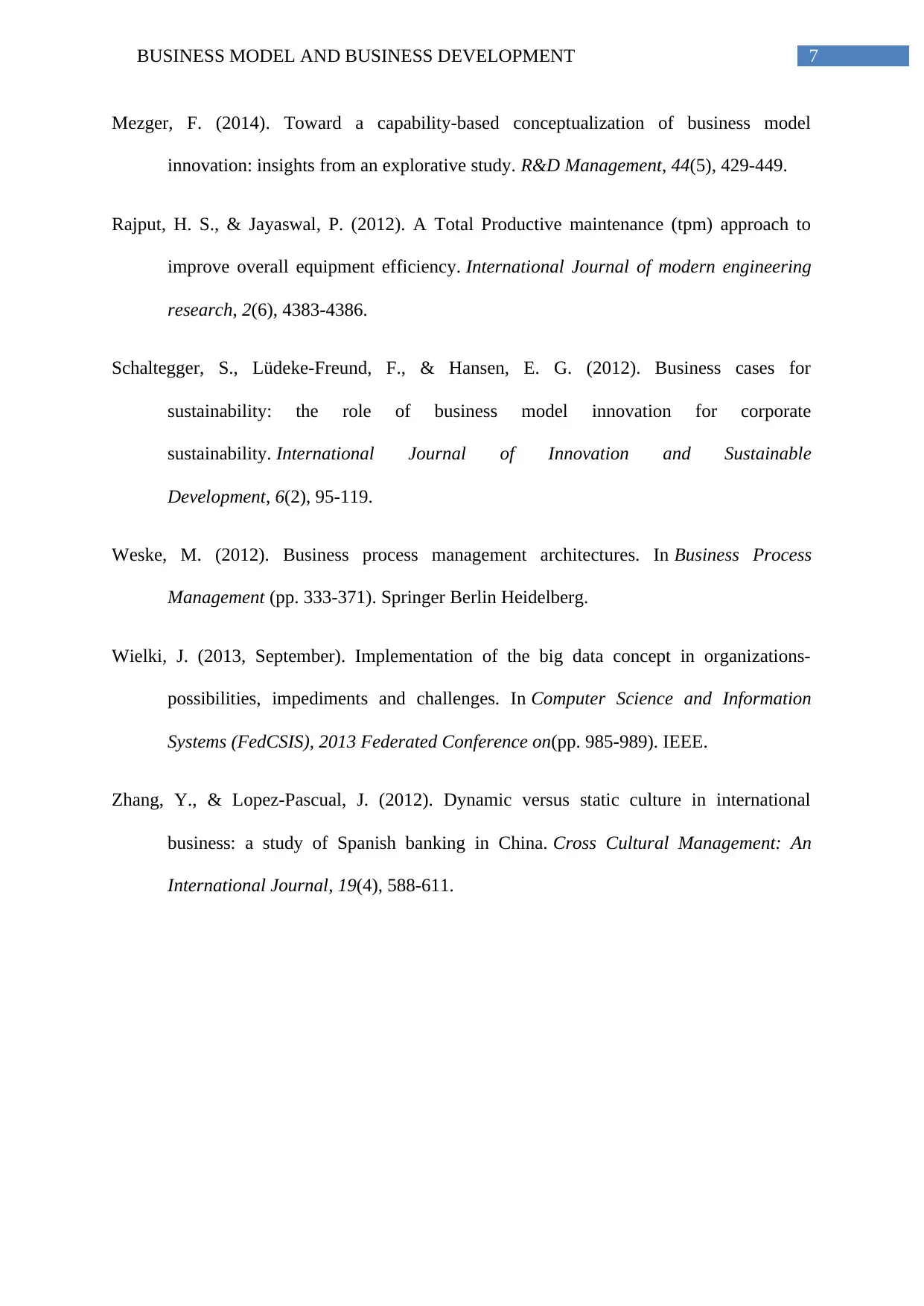
7BUSINESS MODEL AND BUSINESS DEVELOPMENT
Mezger, F. (2014). Toward a capability‐based conceptualization of business model
innovation: insights from an explorative study. R&D Management, 44(5), 429-449.
Rajput, H. S., & Jayaswal, P. (2012). A Total Productive maintenance (tpm) approach to
improve overall equipment efficiency. International Journal of modern engineering
research, 2(6), 4383-4386.
Schaltegger, S., Lüdeke-Freund, F., & Hansen, E. G. (2012). Business cases for
sustainability: the role of business model innovation for corporate
sustainability. International Journal of Innovation and Sustainable
Development, 6(2), 95-119.
Weske, M. (2012). Business process management architectures. In Business Process
Management (pp. 333-371). Springer Berlin Heidelberg.
Wielki, J. (2013, September). Implementation of the big data concept in organizations-
possibilities, impediments and challenges. In Computer Science and Information
Systems (FedCSIS), 2013 Federated Conference on(pp. 985-989). IEEE.
Zhang, Y., & Lopez-Pascual, J. (2012). Dynamic versus static culture in international
business: a study of Spanish banking in China. Cross Cultural Management: An
International Journal, 19(4), 588-611.
Mezger, F. (2014). Toward a capability‐based conceptualization of business model
innovation: insights from an explorative study. R&D Management, 44(5), 429-449.
Rajput, H. S., & Jayaswal, P. (2012). A Total Productive maintenance (tpm) approach to
improve overall equipment efficiency. International Journal of modern engineering
research, 2(6), 4383-4386.
Schaltegger, S., Lüdeke-Freund, F., & Hansen, E. G. (2012). Business cases for
sustainability: the role of business model innovation for corporate
sustainability. International Journal of Innovation and Sustainable
Development, 6(2), 95-119.
Weske, M. (2012). Business process management architectures. In Business Process
Management (pp. 333-371). Springer Berlin Heidelberg.
Wielki, J. (2013, September). Implementation of the big data concept in organizations-
possibilities, impediments and challenges. In Computer Science and Information
Systems (FedCSIS), 2013 Federated Conference on(pp. 985-989). IEEE.
Zhang, Y., & Lopez-Pascual, J. (2012). Dynamic versus static culture in international
business: a study of Spanish banking in China. Cross Cultural Management: An
International Journal, 19(4), 588-611.
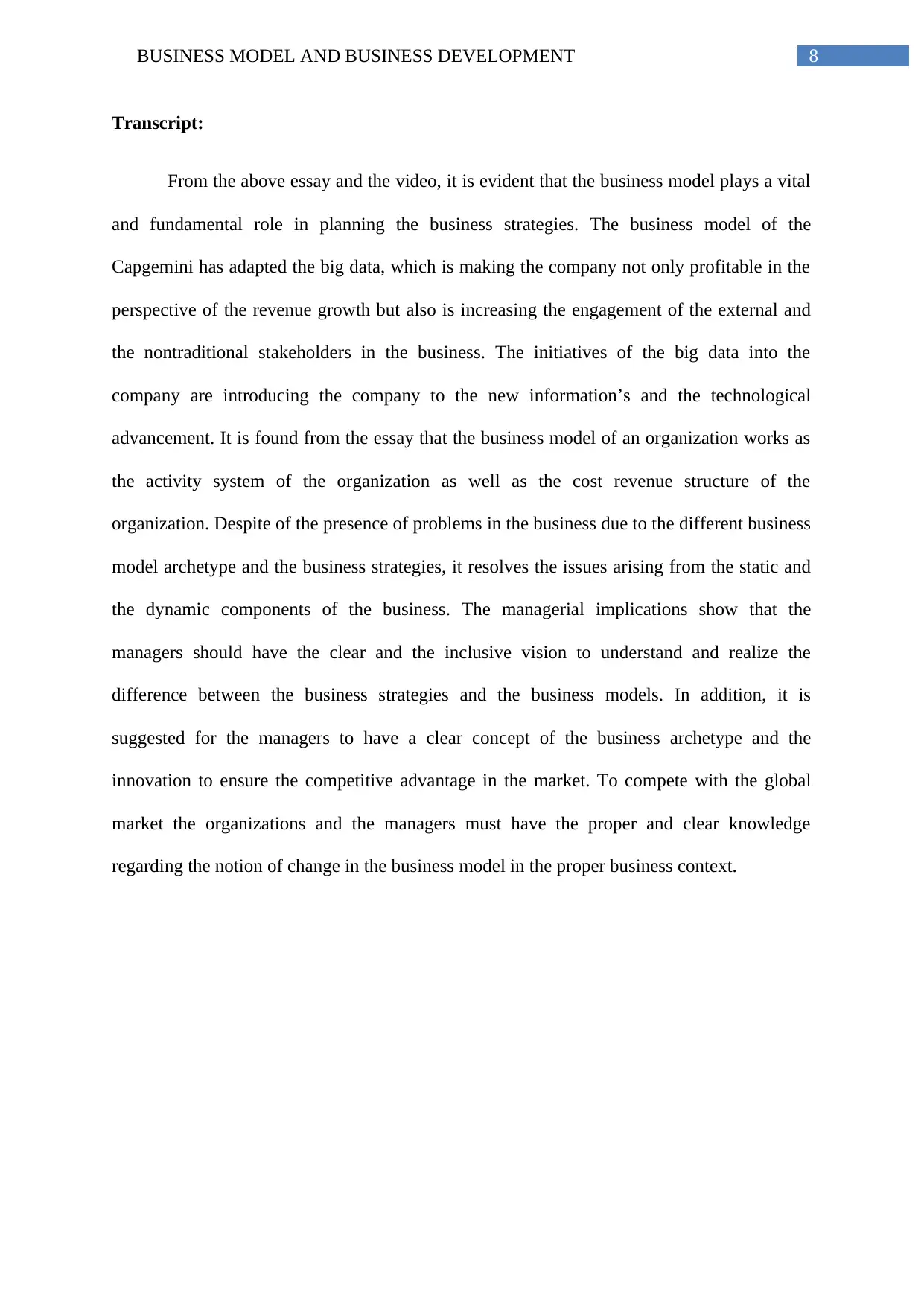
8BUSINESS MODEL AND BUSINESS DEVELOPMENT
Transcript:
From the above essay and the video, it is evident that the business model plays a vital
and fundamental role in planning the business strategies. The business model of the
Capgemini has adapted the big data, which is making the company not only profitable in the
perspective of the revenue growth but also is increasing the engagement of the external and
the nontraditional stakeholders in the business. The initiatives of the big data into the
company are introducing the company to the new information’s and the technological
advancement. It is found from the essay that the business model of an organization works as
the activity system of the organization as well as the cost revenue structure of the
organization. Despite of the presence of problems in the business due to the different business
model archetype and the business strategies, it resolves the issues arising from the static and
the dynamic components of the business. The managerial implications show that the
managers should have the clear and the inclusive vision to understand and realize the
difference between the business strategies and the business models. In addition, it is
suggested for the managers to have a clear concept of the business archetype and the
innovation to ensure the competitive advantage in the market. To compete with the global
market the organizations and the managers must have the proper and clear knowledge
regarding the notion of change in the business model in the proper business context.
Transcript:
From the above essay and the video, it is evident that the business model plays a vital
and fundamental role in planning the business strategies. The business model of the
Capgemini has adapted the big data, which is making the company not only profitable in the
perspective of the revenue growth but also is increasing the engagement of the external and
the nontraditional stakeholders in the business. The initiatives of the big data into the
company are introducing the company to the new information’s and the technological
advancement. It is found from the essay that the business model of an organization works as
the activity system of the organization as well as the cost revenue structure of the
organization. Despite of the presence of problems in the business due to the different business
model archetype and the business strategies, it resolves the issues arising from the static and
the dynamic components of the business. The managerial implications show that the
managers should have the clear and the inclusive vision to understand and realize the
difference between the business strategies and the business models. In addition, it is
suggested for the managers to have a clear concept of the business archetype and the
innovation to ensure the competitive advantage in the market. To compete with the global
market the organizations and the managers must have the proper and clear knowledge
regarding the notion of change in the business model in the proper business context.
⊘ This is a preview!⊘
Do you want full access?
Subscribe today to unlock all pages.

Trusted by 1+ million students worldwide
1 out of 9
Related Documents
Your All-in-One AI-Powered Toolkit for Academic Success.
+13062052269
info@desklib.com
Available 24*7 on WhatsApp / Email
![[object Object]](/_next/static/media/star-bottom.7253800d.svg)
Unlock your academic potential
Copyright © 2020–2025 A2Z Services. All Rights Reserved. Developed and managed by ZUCOL.





